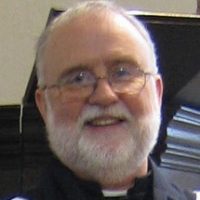St James the Elder is the parish church of Llanvetherine

Church of St James the Elder, Llanvetherine
Llanvetherine church is set in a churchyard sloping down to the River Trothy. Built of old red sandstone with a corbelled tower, the simple interior was possibly rebuilt in the 15th and 16th centuries.
Features include the lovely timber pulpit with panels of leafy branches and typical lettering. Also you will find interesting monuments including the worn figure of a priest and a life-size relief of a bearded man in academic gown holding a book.
The church of St James the Elder was built just above a tributary of the River Trothy beside what is now the B4521, the Old Ross Road, and is about 6 miles east of Abergavenny. The name ‘Llanvetherine’ is an Anglicised word broadly meaning ‘the parish or land of Gwytherine’. The church and its glebe land were mentioned in the Book of Llandaff, written in about 1150.
‘Cors and Morwyd gave the Church of Saint Gueithirin with three modii of land around it. After a time Cors on his own account gave another three modii above the road next to the other land already mentioned.’ [Three modii is about 27 acres.]
The gift of land was made when Nud was Bishop of Llandaff, and he was among the Clerical Witnesses of the Gift. Bishop Nud is thought to have lived somewhere between 850 and 916, and if so, there has been a Church on this site since at least 150 years before the Norman Conquest. The present building has several Pre–reformation features. The Churchyard has many interesting tombstones of mixed antiquity and legibility.
We have been unable to discover when the church was dedicated to St James, but the wardens were visited in 2014 by an enthusiast for holy wells. She had previously identified two sites, east and west of the church, where holy wells are likely to have been sited. She also pointed out that churches were often dedicated to St James when they were stations along medieval pilgrim routes.
There is a small Priest’s Door in the south wall of the Chancel through which the Pre-reformation priest would have entered to say Mass. In the Old Church, Mass was said in Latin beyond the Rood Screen, out of sight or physical involvement of the congregation in the Nave. The Rood Screen would have divided the Chancel (or Quire) from the Nave.
In the south wall of the Nave there is a tall semi–circular headed window dated 1703. This window allows light onto the pulpit although its original purpose is uncertain. Outside the pulpit window, in the churchyard are the remains of a churchyard or ‘preaching’ cross.
The Porch has a Holy Water Stoop near the main south door, another Pre-reformation feature. A medieval sword has been crudely carved into the threshold of the south door, much of it worn away, but the parts of the hilt are obvious.
Inside the Church there is a Piscina in the southeast corner of the Nave near the Pulpit, and another in the south wall of the Sanctuary. Inside the Chancel Arch is a door on the north side behind the Quire pews. This now leads into a recess, but it was originally the door to the steps leading up to the Rood Loft. On the East wall of the Sanctuary, either side of the East Window, there are two full length stone reliefs of a former Rector and his wife. The Revd David Powell, who died in 1621 after an incumbency of 45 years, was an MA and Fellow of All Souls College, Oxford. His inscription refers also to his son Valentine, another MA and Rector of Llanvetherine. Mary Powell, wife of David, is shown wearing a Welsh hat and her hands are clasped in prayer. Her feet are oddly placed at right angles to her legs. In his book on the County of Monmouthshire, a well-known Gwent historian, Fred Hando, drew attention to the position of Mrs Powell’s ring:
‘The ring on the second finger of her right hand reminds us that until 1549 the wedding ring was worn on the fourth finger of the right hand.’
There is a large stone laid flat in the Sanctuary to the north of the Altar. It shows a relief figure with one arm raised in blessing. The carving is rather crude, suggesting a considerable age. It was found buried deep under the Chancel during excavations in 1750 and is said to be a carving of Saint Gwytherin himself. It was put outside but eventually began to show signs of deterioration. Within recent memory it was carried back inside to its present position in the church by a group of farmers.
Little seems to be known about the Celtic Saint Gwytherine. Possibly he was the son of Dingat ap Nud Heal, who lived in the 6th Century. There is another Church dedicated to him in Denbighshire in North Wales.
The oldest feature of the Church appears to be the Tower, the upper part of which is jettied. The cradle is made to hold three bells, but there are only two, dated 1582 and 1653 respectively.
The most recent significant changes are probably Victorian and Edwardian. The Nave and Vestry roofs appear more recent, the Chancel archway was restored in 1872, and the current carved oak ‘screen’ is characteristic of the Arts and Crafts movement with Art Nouveau lettering and intricate carvings surrounding the Pulpit but we have yet to find a date or maker’s mark. The East Window is dated 1905 and depicts the Nativity in painted medieval romantic style reminiscent of the Pre-Raphaelites. Unusually Mary is depicted wearing red.
At the time of preparation, to the great regret of the wardens, it isn’t normally possible to keep the church unlocked outside services although there are hopes to be able to make arrangements before long. There is a small lay-by on the opposite side of the B4521 road.
This description has been written for the website, adapted and updated from a leaflet written by the late Mrs Margaret Francis (d. 2005), whose Remains now lie in the Churchyard.
Llanvetherine has no village war memorial. However, there are some notable memorials in the churchyard which remember those who served in the World Wars. Following tree surgery adjacent to the road an interesting gravestone came to light. The gravestone identifies William Thomas Keylock, MM, a gunner in the Tank Corps, who evidently was killed in action on 3rd October 1918, a few weeks before the end of WW1, in Estrees. Online searches have revealed that William Keylock is buried in Prospect Hill Cemetery, Gouy, France. Very little is know about him but records identify his wife as B. Gillett (formerly Keylock), of 19A, Woodland Terrace, Cwmtillery, Abertillery, Mon. Is anyone able to throw any light on this gallant man who might possibly deserve remembering each November?
Next to the footpath, about ten yards in from the churchyard gate, is the grave on Eli Withers on which is remembered his son, also named Eli Withers, who was lost at sea aboard HMS Glorious in 1940 aged just 21.
“Fred and Harri” In Llanvetherine Church there is a beautiful stained glass window donated by the Watkins family, Wernycwm. The picture shows the two saints to which the church is dedicated, St James the Elder and St Gwytherin. However, to older residents of the parish they represent Fred and Harri, the two bachelor brothers who farmed Wernycwm for many years, having lived there throughout their lives. When I was in school my parents kept the village post office. I used to deliver the mail to Wernycwm to help my father before catching the school bus. Fred and Harri were always most welcoming and their housekeeper, Mrs Reynolds used to give me a cup of tea. I could never look at our Church window without remembering the two brothers, one tall and serious and the other short and jolly. I wonder how many people remember the Watkins brothers?
Anne Beavan, Great Tre-rhew Farm













